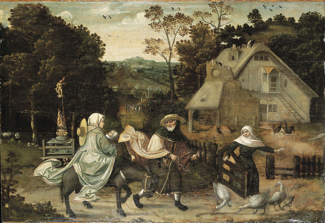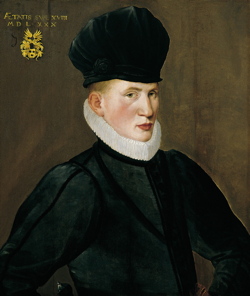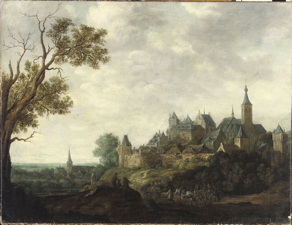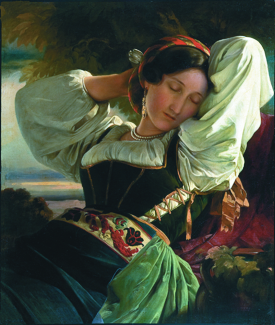Shedding light on Nazi-looted art

In a poignant ceremony last October, the painting The Masters of the Goldsmith Guild in Amsterdam in 1701 by Dutch artist Juriaen Pool II was returned by a German casino to the estate of the late Montreal art dealer Max Stern, LLD 85, at the Amsterdam Museum in the Netherlands. It was an emotional moment for those involved.
“Recovering this ninth painting was extremely gratifying after a decade of attempting to have German entities own up to the fact that the restitution of Nazi-looted artwork remains a serious issue,” says Clarence Epstein, director of special projects and cultural affairs at Concordia, who has spearheaded the Max Stern Art Restitution Project since its launch 10 years ago.
After the Jewish Stern fled his native Germany in the late 1930s and regained his bearings in Canada a few years later, he sought to reclaim many of the paintings that various agents of the Nazi government had forced him to liquidate along with his art gallery in Düsseldorf.
Stern recovered a few, but the resolve of the man who revolutionized Canada’s art scene until his death in 1987 later inspired the executors of his estate and three university beneficiaries, Concordia, McGill and Hebrew University in Jerusalem.
“The Stern project is the largest initiative of its kind in Canada and one of the most recognized restitution efforts in the world,” Epstein says. The stories behind each painting’s recovery vary from heartening to heartbreaking, with some unfolding like the pages of a thriller, with stakeholders, allies and enemies.
McGill and Hebrew University have provided ongoing moral support and helped with outreach, mobilization and networking, but Concordia has been at the project’s forefront from the outset.
“There’s a high level of support among the university’s administrators, faculty members, students and staff, which obviously stems from the desire to right some of the wrongs committed during the Holocaust, but also the rather unique ability of a large institution to act as a moral compass and be a family of sorts for a man who didn’t have children of his own to continue his efforts.”
The estate’s executors approved of the project’s creation after learning in 2002 that works belonging to the Galerie Stern were recirculating on the art market. The primary objective isn’t financial profit but to perpetuate the recovery efforts.
During the initial five years, the project team identified potentially helpful resources and their associated costs and worked to establish factual arguments for the Stern claims.
Philip Dombowsky, BFA 84, MFA 95, who catalogued the Max Stern collection of documents bequeathed to the National Gallery of Canada, prepared the first report on the missing art. The estate then appointed Willi Korte, a renowned specialist in tracking down looted art, as the chief investigator.
“Dr. Korte is a remarkable lawyer and historian and has been pivotal to every recovery because of his extensive international connections,” says Catherine MacKenzie, professor and acting chair of Concordia’s Department of Art History.
Providing a Beacon
With access to Korte and Dombowsky’s files, MacKenzie set out with her MA students to curate an exhibition titled Auktion 392: Reclaiming the Galerie Stern, Düsseldorf, which opened at Concordia’s FOFA Gallery in 2006.
The exhibition featured grey-toned images — or “ghosts” — of paintings sold by Lempertz Auction House in 1937 from the liquidation of Stern’s gallery. The grey images represent the absence of these paintings from Stern’s life and how their successful restitution might restore some colour to a dark period in history.
MacKenzie, who embarked on the project as a relative neophyte about Nazi looting, presented the story in a way she could relate to it.
“Before reading Dr. Korte’s extensive research, I didn’t realize the full extent to which looted art was given to Nazi supporters to keep them on side,” she says. While many believe this practice started with Kristallnacht (the Night of Broken Glass) in 1938, MacKenzie reports “it began soon after Hitler came into power in 1933.”
Auktion 392 has been the project’s beacon, travelling to the Leo Baeck Institute in New York City and the Ben Uri Gallery (London Jewish Museum of Art) in England, and under Ben Uri’s management to Jerusalem, several venues in the United Kingdom and the Jewish Museum of Florida in Miami.

MacKenzie’s research for the exhibition’s catalogue played a significant role in reclaiming Emile Vernet-Lecomte’s Aimée painting of a young Egyptian woman as the project’s first successful restitution in October 2006.
“We already suspected it belonged to Stern when we heard it was coming up for resale under a different title,” MacKenzie says. “Through an interlibrary loan, I obtained an 1895 exhibition catalogue that contained a black-and-white photographic image of the painting described in Stern’s catalogue.”
About a week after MacKenzie contacted Sotheby’s auction house specialists with her findings, they subsequently returned the painting to the Stern estate in time to be announced before the Auktion 392 Montreal opening.
MacKenzie actually hopes the exhibition will soon outlive its value. “People have become aware of Max Stern’s story because of the significant media attention to the project’s restitution efforts,” she says. “You can no longer pretend to have an interest in culture and not know about the Nazi looting of art.”
The greater public awareness is largely a result of efforts by Concordia’s University Communications Services and its Media Relations team at every key stage.
“Media Relations has done an extraordinary job of conveying what at times have been very difficult or time-sensitive issues, such as when certain European auction houses have refused to remove or delay the sale of paintings with questionable provenance,” says Epstein.
Media Relations director Christine Mota, BA 77, and Nadia Kherif have been involved since the project’s inception. Fiona Downey, BA 83, has been on board since 2009.
“From a communications perspective, the Stern story is a gift, because of its undercurrents of justice and moral obligations,” Mota says. “It helped put Concordia onto the world stage because Max Stern’s life is a story that resonates with so many families of European origin, living here and abroad.”
The project’s research team continues to update an extensive database developed by Concordia to help locate other missing paintings. Key developments are posted on the project’s website.
INTERPOL and Magdeburg’s Lost Art database in Germany also maintain active lists of the works that should be returned to the Stern estate.

The Circle of Jan Wellens de Cock Flight into Egypt painting was delivered in time for an international conference on restitution in Berlin.
“We held a briefing there on the eve of the conference, making it clear that we intended to pursue restitution across Europe,” Epstein says.
“We also petitioned the German government to acknowledge the Stern project as a critical gesture in establishing their position regarding restitution, and were very pleased when the minister of culture made reference to the project in his remarks the next day.”
Change, however, often takes time. “Recommendations have been made, but numerous matters have to be considered before they become law, such as the particular rights some German museums and members of the art trade are claiming,” Epstein explains.
Portrait of a Recovery
A second painting — a portrait of Jan van Eversdyck by Nicolas Neufchatel — was recovered in February 2007 in time to announce at the New York City Auktion 392 opening. MacKenzie again played a key role.

“I was on the Internet late at night when I either tried another spelling or made a typo and couldn’t believe it when a photographic image of this painting mentioned in a Stern catalogue popped up,” she recalls. “I had to stop myself from phoning Clarence at 3 a.m.”
Lempertz Auction House sold the Neufchatel in 1937 and again in 1977 and 1996 without mentioning the Stern connection in its latter catalogues. The Yannick and Ben Jakober Foundation in Mallorca, Spain, had received the Neufchatel from the 1996 purchaser as a donation.
“When the Holocaust Claims Processing Office (HCPO) in New York provided the documentation, this foundation administered by a Jewish family, who are children of Holocaust survivors, immediately acknowledged the Stern estate’s ownership,” says Epstein.
However, the Spanish government forbids artwork certified as cultural property from being removed from the country. “We had to strike an arrangement whereby the painting’s title was transferred to the estate but the painting remains on permanent loan to this very righteous foundation,” Epstein explains.
The Neufchatel story drew the attention of the Jewish Museum Berlin, Europe’s largest Jewish museum, which requested the work for an exhibition titled Looting and Restitution: Jewish-owned Cultural Artifacts from 1933 to the Present.
“The exhibition segment about the Stern story invited the public to decide on its own whether the Cologne-based auctioneers had repeatedly overlooked the ownership history of the artwork they were re-offering on the market,” Epstein says.
“I remember one curator questioning whether the auction house that has claimed that many of its wartime records were destroyed had ever thought of visiting one of the local libraries to get a copy of the 1937 catalogue.”

In December 2007, a third painting — a landscape of travellers in a walled town by Jan de Vos I — was returned by Christie’s auction house. “The de Vos represented a milestone because it’s one of a large number of artworks relinquished by the Galerie Stern during the period of duress prior to the 1937 forced sale,” Epstein says.
The project’s capstone to date has been the return of The Girl from the Sabine Mountains by Franz Xaver Winterhalter in January 2008. The Art Loss Register, an international organization based in London with a database of stolen and missing artwork and other valuables, alerted Concordia after the stepdaughter of the 1937 buyer, Baroness Von Morsey Pickard, put the Winterhalter up for sale.

After failed, good-faith negotiations led by the HCPO, the Stern estate sued the baroness, who was living in Providence, R.I. Her lawyers argued that the plaintiffs’ delay in pursuing the matter had caused her undue prejudice.
In December 2007, the U.S. district court for Rhode Island sided with the estate. In an unprecedented ruling, it equated a forced sale to a theft. “When you have an American federal judge rendering a decision that’s subsequently upheld on appeal, it’s no longer just three universities arguing the point,” says Epstein. “U.S. Customs and Homeland Security now have a court-supported mandate to seize other Stern works found on American soil.”
Mota calls the Winterhalter’s retrieval the stuff of movies. “There’s a German aristocrat refusing to acknowledge a wartime wrongdoing; unprecedented judgments in favour of full restitution; and the baroness subsequently attempting to circumvent justice by shipping an important painting out of the U.S. back to her native Germany, stating a $50 value on her custom declaration,” she says.
Delivering The Bagpiper
Shortly after the ruling, a student researcher at the HCPO came across the Northern Netherlandish School’s Portrait of a Musician Playing a Bagpipe in a New York gallery and, once again, the Stern project became somewhat of a thriller.
As a result of the Winterhalter decision equating the 1937 sale to a theft, law enforcement agents immediately sprang into action. Undercover investigators posed as clients to view The Bagpiper. INTERPOL agents confirmed the work was on loan at a European fair. Customs officials seized the work upon its return to the U.S.
The dealer had recently bought The Bagpiper from another dealer in London, who had not long before purchased it from Lempertz. When this prominent dealer returned to Lempertz demanding a refund, the German auction house refused to do anything for him.
Less than a month after The Bagpiper was delivered to the Stern estate in April 2009, another New York member of the art trade informed Concordia that he also had a painting from the forced sale and wanted to return it.
Richard Feigen, one of the world’s leading Old Master dealers, was about to lend the Lodovico Carracci painting of St. Jerome to a Yale University exhibition, but contacted Concordia as soon as he read about The Bagpiper in The New York Times.
Rarely do things happen with such little effort, however. The Stern project had to wait for years while the Netherlands government investigated the estate’s 2005 claim for the Jan Brueghel the Younger (Brueghel II) painting titled Allegory of Earth and Water.
“It took five years, but the Dutch government must be commended for recognizing that Stern feared for his life under the Nazis and was certainly in no position to retain the full documentation proving his ownership of that artwork,” Epstein says.
The fact that Sotheby’s officials alerted the Stern project about the Juriaen Pool painting returned last October indicates how much the project has accomplished within 10 years.
“Sotheby’s asked whether it was linked to that problematic era of the Düsseldorf gallery,” Epstein explains. “After considerable research, our project team located a client card that Dr. Stern used to jot a note about a client’s interest in the painting.”
Pool’s restitution is sweet for other reasons. “The return was arranged to take place in the Amsterdam Museum’s newly opened children’s wing, which is the site of the civic orphanage where Pool, its most famous resident, was raised,” Mota explains. “A story doesn’t get better than that.”
Julie Gedeon, BA 89, BA 01, MA 09, is a Montreal-area writer and editor and reported on the Stern project for the December 2004 Concordia University Magazine.
Related links:
• The Max Stern Art Restitution Project
• “Stern’s final bow” — Concordia University Magazine, December 2004
• Auktion 392: Reclaiming the Galerie Stern, Düsseldorf